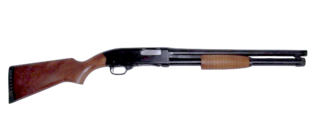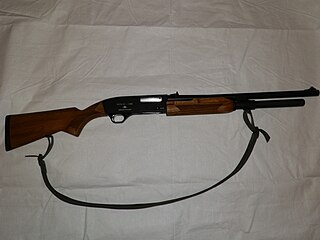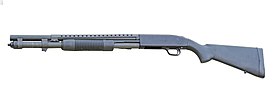The Winchester Model 1897, also known as the Model 97, M97, Riot Gun, or Trench Gun, is a pump-action shotgun with an external hammer and tube magazine manufactured by the Winchester Repeating Arms Company. The Model 1897 was an evolution of the Winchester Model 1893 designed by John Browning. From 1897 until 1957, over one million of these shotguns were produced. The Model 1897 was offered in numerous barrel lengths and grades, chambered in 12 and 16 gauge, and as a solid frame or takedown. The 16-gauge guns had a standard barrel length of 28 in (71 cm), while 12-gauge guns were furnished with 30 in (76 cm) barrels. Special length barrels could be ordered in lengths as short as 20 in (51 cm) or as long as 36 in (91 cm). Since the time the Model 1897 was first manufactured, it has been used to great effect by American military personnel, law enforcement officers, and hunters.

The Mossberg 500 (M500) is a series of pump action shotguns manufactured by O.F. Mossberg & Sons. The 500 series comprises widely varying models of hammerless repeaters, all of which share the same basic receiver and action, but differ in bore size, barrel length, choke options, magazine capacity, stock and forearm materials. Model numbers included in the 500 series are the 500, 505, 510, 535, and 590. The Revelation 310 and the New Haven 600 were also variations of the 500 series produced by Mossberg under different names. By 2021, 11,000,000 M500s had been produced, making it the most-produced shotgun of all time.
Pump action is a type of manual firearm action that is operated by moving a sliding handguard on the gun's forestock. When shooting, the sliding forend is pulled rearward to eject any expended cartridge and typically to cock the hammer or striker, and then pushed forward to load a new cartridge into the chamber. Most pump-action firearms use an integral tubular magazine, although some do use detachable box magazines. Pump-action firearms are typically associated with shotguns, although it has been used in rifles, grenade launchers, as well as other types of firearms. A firearm using this operating mechanism is colloquially referred to as a pumpgun.

The Franchi SPAS-12 is a combat shotgun manufactured by Italian firearms company Franchi from 1979 to 2000. The SPAS-12 is a dual-mode shotgun, adjustable for semi-automatic or pump-action operation. The SPAS-12 was sold to military and police users worldwide, as well as on the civilian market.
The Benelli Nova is a pump action shotgun, used for hunting and self-defense. It has a one-piece receiver and buttstock, made of steel-reinforced polymer.

The Saiga-12 is a shotgun available in a wide range of configurations, patterned after the Kalashnikov series of rifles and named after the Saiga antelope native to Russia. Like the Kalashnikov rifle variants, it is a rotating bolt, long-stroke gas piston operated firearm that feeds from a square magazine. All Saiga-12 configurations are recognizable as Kalashnikov-pattern guns by the large lever-safety on the right side of the receiver, the optic mounting rail on the left side of the receiver and the large top-mounted dust cover held in place by the rear of the recoil spring assembly. Saiga firearms are meant for civilian domestic sale in Russia, and export to international markets.
The Winchester Model 1887 and Winchester Model 1901 are lever-action shotguns originally designed by famed American gun designer John Browning and produced by the Winchester Repeating Arms Company during the late 19th and early 20th centuries. The shotgun has become iconic for its use in the 1991 film Terminator 2: Judgment Day.
The Maverick 88 is a pump action shotgun manufactured for O.F. Mossberg & Sons. The Maverick 88 is virtually identical to the Mossberg 500. Factory Maverick 88s feature a black, synthetic only stock and forearm, cylinder bore, and cross-bolt safety. Most accessories not dealing with the trigger are interchangeable with a Mossberg 500.

The ArmaLite AR-7 Explorer is a semi-automatic firearm in .22 Long Rifle caliber, developed in 1959 from the AR-5 that was adopted by the U.S. Air Force as a pilot and aircrew survival weapon. The AR-7 was adopted and modified by the Israeli Air Force as an aircrew survival weapon in the 1980s.

The Model 1200 is a pump-action shotgun that was manufactured by the Winchester-Western Division of Olin Corporation, starting 1964. It was redesignated the Model 1300 in 1978 with minimal changes. Production ceased in 2006 when the U.S. Repeating Arms Company, the subsequent manufacturer, went bankrupt. A militarized version of the Model 1200 was acquired by the U.S. Army for use during the Vietnam War. It is still in active service within various conflicts throughout the 21st century.
The Remington Spartan 100 is a single-shot, break-action shotgun. It is a variant of a classical Russian IZh-18 shotgun manufactured by Izhevsk Mechanical Plant for export under trademark "Baikal", in Izhevsk, Russia. It is marketed and distributed by Remington.
The Fabarm FP6 is a pump-action combat shotgun that was manufactured by the Italian firearms company Fabbrica Bresciana Armi S.p.A. (FABARM) and sold by Heckler & Koch. It was intended for civilian and law enforcement use.
The Winchester Model 69 is a bolt-action .22 caliber repeating rifle first produced in 1935 by the Winchester Repeating Arms Company. It was marketed as Winchester's mid-priced bolt-action rimfire sporting rifle, positioned above inexpensive single-shot rifles such as the Model 68 and beneath the prestigious Model 52. Model 69/69A were sold with both a short and Long Rifle 5 shot magazine magazine until circa 1950.
New Haven 600 is a series of pump-action shotguns manufactured by O.F. Mossberg & Sons on behalf of department stores, most notably the Montgomery Ward Company, Western Auto, and other retail stores. New Haven is one of O.F. Mossberg & Sons' private, promotional brands. The New Haven 600 is identical to the Mossberg 500 from O.F. Mossberg & Sons, with the addition of an anti-rattle system in the magazine tube, and the top of the receiver is not drilled out of a scope mount. Many of the 600AT models came with adjustable C-Lect Chokes. The 600 series comprises widely varying models of hammerless, pump action repeaters, all of which share the same basic receiver and action, but differ in bore size, barrel length, choke options, magazine capacity, and "furniture" materials.

The Molot Bekas-M is a series of Russian pump-action shotguns manufactured by the Molot machine plant in Vyatskie Polyany, Kirov Oblast. The Bekas-M series comprises a wide variety of models, all of which share the same basic receiver and action, but differ in barrel length and choke options. Some models are sold in combination sets, some are supplied with a plastic pistol grip, and most models have a walnut stock and forearm. Its classical design and consistent quality, together with the availability of low-priced sets with two barrels, helped it to gain popularity among hunters and home-defense enthusiasts in Russia.

The Savage Model 24 is an American made over-and-under combination gun manufactured by Savage Arms. The basic .22LR over .410 gauge model weighs 7 pounds, has 24-inch barrels and an overall length of 41-inches. It may also be disassembled for ease of storage.
The Mossberg 183 is a .410 bore bolt-action shotgun, produced between 1947 and 1986 by O.F. Mossberg & Sons in New Haven, Connecticut.
The Stevens Model 520 was a pump-action shotgun developed by John Browning and originally manufactured by the J Stevens Arms & Tool Company between 1909 and 1916. Stevens was sold to New England Westinghouse on 28 May 1915 and production of civilian firearms was greatly reduced. The company was renamed the "J Stevens Arms Company" on 1 July 1916 and New England Westinghouse used their manufacturing facility in Chicopee Falls, MA to produce Mosin-Nagant rifles under contract for the Russian Czar during World War I. After the war, Stevens was sold to Savage Arms on 1 April 1920 and full production of civilian firearms resumed. Under Savage ownership, Model 520 production continued until 1939 when it was replaced by the Model 520A which ended production in 1948. Stevens also further modified the design when they introduced the streamlined Model 620 in 1927. The Model 620 was internally similar to the Model 520 and was produced until 1939 when it was replaced by the Model 620A which ended production in 1955. This shotgun is a hammerless, pump action, take-down design with a tubular magazine which holds 5 shells. All models can also be slam fired: the shotgun has no trigger disconnector and shells can be fired one after the other simply by working the slide if the trigger is held down.
The DP-12 is a bullpup 12-gauge pump action double-barreled shotgun designed by Standard Manufacturing. It has two tube magazines, each of which feeds its own barrel. Each magazine tube can hold up to seven 2.75-inch (70 mm) 12-gauge shotshells or six 3-inch (76 mm) shotgun shells. 16 (2¾") or 14 (3") in total with indicator windows.
The Beretta 1301 is a gas-operated semi-automatic shotgun produced by Beretta and imported by Beretta USA in the United States. The firearm has two separate designs. One is intended for tactical self-defense, and law enforcement applications, whereas the other is designed for target shooting sports. Despite its intended applications, it is often used by a minority of hunters and sporting clay shooters.








